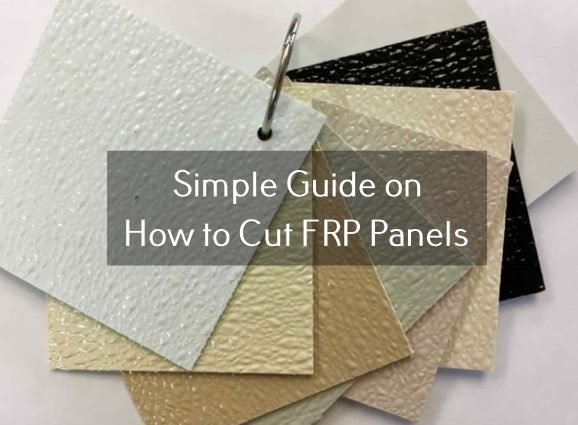FRP is a common abbreviation that stands for the Fiberglass Reinforced Plastic. It is a strong, durable, and relatively lightweight material suitable for various wall paneling purposes. Cutting FRP panels accurately and cleanly is essential to achieve a professional finish.
Before you install this type of panel, it must be cut to fit your walls’ size. Learn the steps to cut FRP panels in the following.
How to Cut FRP Panels in Four Steps
To cut the FRP panel, there are a few things to consider: how much you need to trim away and the inevitable material contraction and expansion size. In this article, we’ll explore the tools and techniques for cutting FRP panels, including using carbide-tipped tools, metal shears, and achieving fine-tooth straight cuts.
For the thicker panel, it’s more convenient to use a mechanical saw or drill with carbide coats. The tool must be sharp and clean as the glass fiber is severely abrasive.

After you’ve gathered all your supplies, tools, and safety equipment, it is time to execute the cutting process. Here is the guide of what you have to do:
1. Put on the safety equipment as your protection
The safety tools you need include safety glasses and leather gloves. If necessary, use a respirator to prevent dust from the paneling pieces that fly around the air.
2. Measure the size
The next step to cut FRP panels is to use a tape measure and apply it to the glass fiber sheet. Mark the edge of your cutting panel by using a carpenter pencil. To create a symmetrical line across the board, mark the edge points of your panel repeatedly. You might want to complete this step by putting the FRP sheet over the table to provide a sturdy and solid surface.
3. Utilize a circular saw to cut your panel
Carbide-tipped tools are excellent for cutting FRP panels due to their durability and precision. The carbide tips are incredibly hard, making them ideal for using abrasive materials like FRP.
Create a line between two marks, a pencil, and a chalk line, that sets the carbide blade from a circular saw. The circular saw must be placed on the right of the line to make it noticeable from the table’s edge. Ensure the sheet is facing down, but if you’re cutting FRP with a table saw, ensure it is facing up.
Read also: Miter Saw VS Circular Saw
After setting the marking line, align the circular saw’s carbide blade with the guiding chalk line. Then press the tool’s trigger and move it slowly against the fiberglass sheet. The carbide blade of the circular saw must be kept aligned throughout the cutting process.
4. Complete the process of cutting the panel
Trying to learn how to cut FRP panels with a utility knife might be hard, but the knife can be used as part of the finishing process. Place the sharp side of your knife against the FRP sheet.
Tilt the sharp side at a 15° angle, then drag it on the panel edge to get rid of the burr edge. Remember not to push the blade as it will damage your sheets overly.
Metal Shears for Quick Cuts
Using metal shears, particularly electric or pneumatic shears, can quickly cut straight lines in fiber-reinforced polymer panels. They are useful for making long, straight cuts because they function by basically “biting” through the material. This is how to apply them:
- Mark your cut line on the FRP panel using a straightedge or a square.
- Line up the cutting edge of the metal shear with the indicated line.
- To cut along the line, lightly squeeze the trigger or attach the shears. Maintain a constant, uniform feeding rate to prevent chipping or cracking.
- To keep a straight cut, move slowly and steadily.
Some have wondered about you can screw FRP panels during installation, and the answer is yes. It also needs adhesive as well. After you cut the sheet using the guide above, the products must be sealed to prevent corrosion of glass fiber. To avoid corrosion, some manufacturers use comparable resin.


